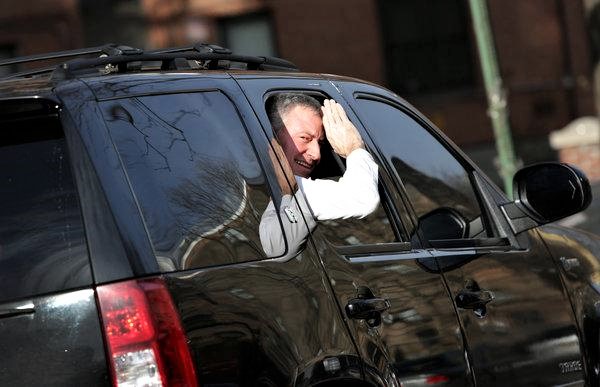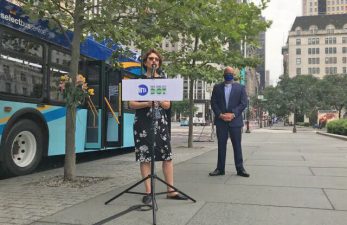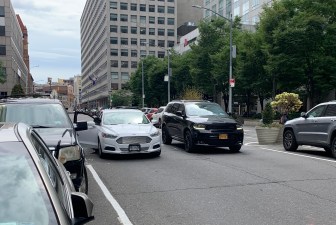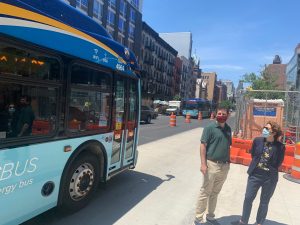De Blasio Says, ‘Busways? Busways? But I Fixed Alternate-Side Parking!’

The mayor’s brain is stuck in park.
Mayor de Blasio accidentally gave away his transportation priorities on Brian Lehrer’s “Ask The Mayor” segment on Friday, brushing off a bus rider who asked about the status of the city’s currently stalled effort to put down 20 miles of dedicated bus lanes and car-free busways — only to later get an earful from the mayor about his passion for reducing alternate-side parking regulations.
Early in the segment, a caller named Natasha identified herself as a bus rider and asked if the mayor could commit to getting all 20 miles of his administration’s proposed bus lanes and busways painted by Nov. 1, the end of the striping season. Although he said he was impressed by her knowledge about road painting, the mayor then admitted he had no idea what was going on with his own proposal (which, earlier this year, he complained wasn’t getting enough praise).
I want to give you an update on exactly how far we have gotten. When we announced that, we felt very confident that we could achieve that whole goal and timeline. The truth is, I haven’t gotten a progress report in the last few weeks, so I want to. The last I heard this was moving along very well. There were a couple local issues that were being worked through that still had to be resolved, but overwhelmingly the plan was moving on pace. So let me get you and everyone an update on that.
The 30-second, 89-word, misinformation-filled answer was still getting savaged on Twitter when, a few callers later, another New Yorker asked de Blasio if he had any ideas to avoid double-parking and idling caused by alternate-side parking. Suddenly, the tone shifted and it was the mayor’s time to shine, with a soliloquy twice as long and almost three times as wordy as his answer to a caller asking about a vitally needed transit improvement promise.
I have asked myself this many, many times. So, first of all, thank you for what you said about the schools. And I know we’re all caught up in the tough challenges and the, you know, the blaring headlines, but something that people should be really proud of is that parents and kids and educators, everyone, came together to reopen our schools. And it’s been a really good thing for so many families. But on this alternate side parking, I have felt this since – as a resident, I felt it in my neighborhood in Brooklyn, as a City Councilman. I’ve asked this question a long time, and this is why we’ve been experimenting with reducing the amount of alternate-side parking. There are streets in some parts of the city that had multiple times a week, with alternate side. And I just felt that that caused exactly the problem you’re referring to – a lot of idling, a lot of circling, you know, a lot of traffic jams and problems. So, we’re trying to see if we can reduce it.
In terms of eliminating it, we haven’t found that – we’ve had this conversation a lot over recent months – we haven’t found a model for a city this dense and a city that, you know, really has to be careful about cleanliness, we haven’t found a model that is affordable, that would do what alternate side does when it works. Because there are plenty of times when the street sweeper does come and has an impact. I think your point though is really good. I want to make it as little as possible. I want to see cars moved as infrequently as possible and avoid that idling in particular. So, we’re trying to see if there’s a way to reduce it, responsibly, while still keeping the city clean and stay tuned, we’ll have more to say on that soon.
So if you’re scoring along at home, that’s “No progress report in the last few weeks” for bus improvements to “We’ve had this conversation a lot” for alternate-side parking.
The longer parking answer and the mayor’s treatment of alternate side as The Problem Of Our Age does sadly fit the de Blasio’s transportation style, having earlier this year said he wanted to lighten the burden on New Yorkers who own cars. The mayor even pitched his alternate-side parking tweaks, which reduced the number of days people would have to move their cars, as a social justice issue that gets to the heart of fairness and equity in New York City. Left unsaid in that discussion was whether it was smart to reduce the burden of owning a car when the rate of car ownership in the city outpaced the rate of population growth. (And, of course, true social justice would mean putting the needs of transit users first.)

The mayor clearly does not read Streetsblog, given that we only this week informed the whole internet of the status of the one busway that has been installed since June — and the four that haven’t gone anywhere. So perhaps someone can get the paragraphs below to the mayor, so he can know the update on all his busways:
Other than Jay Street, the other 2.9 miles of car-free busways are in various purgatories:
- The busway on Main Street in Flushing was supposed to be implemented in June, and then in October, but has stalled.
- The Jamaica Avenue busway was slowed down after elected officials asked for it to be moved to Archer Avenue.
- The Fifth Avenue Busway was watered down at the behest of luxury retailers to allow through traffic, and is no longer even a busway.
- The 181st Street Busway in Washington Heights is, in theory, still scheduled for fall 2020 as was originally planned, but October’s community advisory board presentation on the project has not been scheduled yet.
The 16.5 miles of planned bus lanes — make that 14.6 miles, given reductions that the mayor clearly doesn’t know about — have fared somewhat better, though the installations are not all finished:
- .8 miles of bus lanes were installed on 14th Street to extend the block’s busway-adjacent bus lane from First Avenue to Avenue C
- A 2.7-mile bus lane on 149th Street in the Bronx was installed in October.
- A bus lane on Hylan Boulevard on Staten Island was chopped down from 6.6 miles to 4.7 miles this summer, but was installed in September.
- A 6.4-mile bus lane on Merrick Blvd. and 168th Street is supposed to be installed in October.
Advocates reminded the mayor that though his parking obsession is more personal to him, his cherished legacy could be burnished by making the lives of bus riders much easier with nothing but some red paint and political will.
“Bus lanes can be a big part of the mayor”s legacy,” said Riders Alliance spokesman Danny Pearlstein. “They’re something he should really be keeping an eye on because from the perspective of trying to end the Tale of two Cities, this the best bang for the his buck. Three quarters of bus riders are New Yorkers of color, and the bus is a lifeline and an engine of opportunity for people.”





